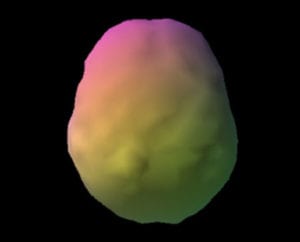Toxic Mold Exposure and Other Toxins
Unlike traditional psychiatry, which rarely looks at the brain, Amen Clinics uses brain imaging technology to help identify toxic exposure that may contribute to psychiatric symptoms.
What is Toxic Exposure?
We’re all familiar with mold. You may have wiped it off your bathroom sink, found it on an old leather coat in the back of your closet, or seen it in your shower. But there’s another type of mold—one that lurks behind the walls, in air ducts, and in crawl spaces that can wreak havoc with your brain health. This type of black mold (Stachybotrys) is actually a toxin that releases toxic gas and spores into the air. When the toxins are inhaled or enter your body through your skin’s pores, the toxic gases can disrupt healthy brain function and impact behavior.
Who is at Risk for Exposure?
Exposure to toxic mold is becoming more common, in part due to construction trends. Homes in America are typically constructed using wood and drywall, where mold thrives. Even worse, did you know that half of the buildings in the United States—schools, hotels, and more—may be water damaged? This makes them prime breeding grounds for mold. However, not everybody is susceptible to developing symptoms from toxic mold exposure. It is estimated that only about 25% of people are vulnerable to mold toxicity due to a genetic predisposition. For example, mold in a home may affect only one family member even though the whole family is exposed to it.
What are the Symtpoms?
From memory loss to depression, there are a number of issues and symptoms associated with mold and other toxic exposure. See box on this page with more potential consequences of exposure.
What Causes Issues?
Many toxins in the environment can harm your brain. On a daily basis, we are exposed to a broad range of chemicals, fumes, pesticides, and products that poison our brain. Some of the more common ones include:
- Fuels
- Asbestos
- Paint thinner
- Carbon monoxide
- Cleaning products
- Pesticides and herbicides
- Nail polish remover & perfumes
- Mercury, lead, and other heavy metals
- Drugs and alcohol
- General anesthesia
- Chemotherapy

Exposure to toxic mold and other toxins can produce a variety of neuropsychological issues, including:
- Depression
- Anxiety
- Mood swings
- Memory problems
- Brain fog
- Irritability
- Confusion
- Sleep disorders
- Exhaustion
- Psychological distress
- Changes in touch or sensation
- Headaches
- Vertigo
- Coordination problems
- Digestive issues
- Numbness
- Pins and Needles feeling
Why Choose Amen Clinics for Treating Exposure to Toxic Mold or Other Toxins?
Because mold toxicity and other environmental toxins can produce such a wide range of symptoms, it is often misdiagnosed. It may be mistaken for a traumatic brain injury, the first signs of dementia, or Lyme disease, or your symptoms may be written off as depression or anxiety. At Amen Clinics, we have diagnosed and treated brain toxicity and the associated neuropsychiatric symptoms in hundreds of people. Amen Clinics use brain SPECT imaging to take the guesswork out of psychiatry. With a comprehensive evaluation, you can get an accurate diagnosis and a treatment plan that is personalized for your needs.
Toxic Brains Work Differently
Based on our brain imaging work—over 200,000 functional brain scans and growing—we can identify patterns in the brain that indicate brain toxicity may be the root cause of symptoms. Toxic exposure is associated with low overall blood flow in the brain and leads to a pattern we call scalloping. When brain toxicity patterns are visible, we perform additional testing and assess your personal history to confirm if mold or other toxins are the underlying problem.

Healthy Brain Scan

Toxic Brain Scan
SPECT (single photon emission computed tomography) is a nuclear medicine study that evaluates blood flow and activity in the brain. Basically, it shows three things: healthy activity, too little activity, or too much activity. The healthy surface brain SPECT scan on the left shows full, even symmetrical activity. The toxic brain scan on the right shows overall decreased activity.
Ready to learn more? Speak to a care coordinator today!
Contact UsThe Consequences of Improper Diagnosis and Treatment
Unfortunately, traditional psychiatry remains the only medical field that rarely looks at the organ it treats, so no one will look at your brain to see if there are signs of toxicity. And most likely no one will even consider that your symptoms might be due to exposure to mold or other toxins. If you visit a healthcare professional with symptoms of depression or memory loss, chances are they will never ask you if you had a water leak at home, if you are a house painter, or if you are a hairdresser.
Because of this, mold toxicity and other types of brain toxicity remain underdiagnosed. The medical community has been slow to acknowledge the association between exposure to mold and other toxins as a cause for psychiatric symptoms. Sadly, when people with undetected exposure to mold or other toxins are misdiagnosed, treatments often don’t work. And in some cases, they can make symptoms worse. Without the appropriate treatment and with continued exposure to the toxin, your brain can be subjected to further injury.
This can eventually lead to a worsening of your symptoms and can impact other areas of your life, including your career and relationships. Without the appropriate treatment, brain toxicity can steal your mind and steal your life.
If you are experiencing psychiatric symptoms and you aren’t responding to treatment, it’s worth investigating if exposure to mold or other toxins may be the root cause.
“With A Better Brain Comes A Better Life”
– Daniel G. Amen, M.D.

